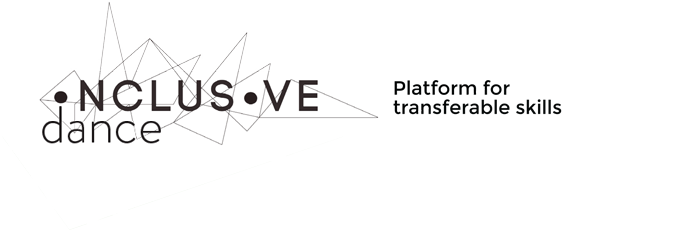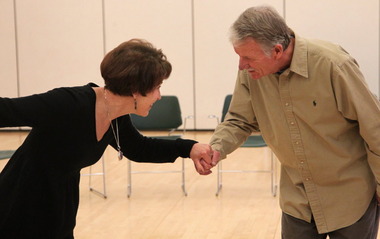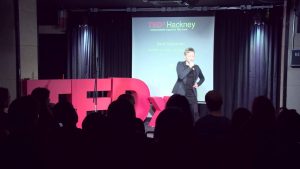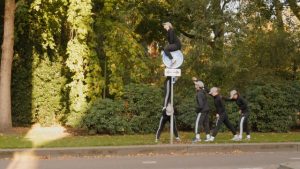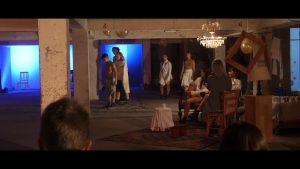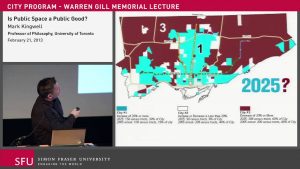Rena Milgrom, certified DMT therapist, shares the basic principles of DMT and her experiences with leading the dance classes for people with Parkinson’s disease.
About Dance Movement Therapy [DMT] for Parkinson’s patients
by Rena Milgrom, CMA, DMT, RSME
Before I get to the benefits of DMT for Parkinson’s patients, I would like to say few words about what DMT is.
The word dance in the title indicates, that dance plays central role here, but in fact the process is very different from conventional dance classes, or from dance used for release and enhancing creative expression.
Dance here represents the entirety of non verbal expression and movement actions that reflects the momentary experience of a person in relationship to the Self and to the outer environment. Every movement carries our past, present and also intent rising from our inner world, which is being affected by the outer world. We can say that it is a sort of a Dialogue between inner and outer, function and expression, mobility and stability and between exertion and recuperation. Movement here is the functioning element, while dance brings testimony about our experience, feelings, sensing, emotions, desires and dreams.
Dance Movement Therapy today is universally defined as a specific kind of psychotherapy, wherein the body or soma is the primary vessel for the socio- psycho-physical integration of the human. All three parts are equally important for human health. Body and Mind are not possible to separate – they are all part of the whole. Therefore, DMT is essentially holistic, being built upon historical roots of therapeutic and spiritual use of dance, cultural anthropology, psycho-dynamic theory, neuro-motor science, psychology of Art and the creative processes.
How do physical exercises, sport, dance forms as for example Tango differ from Dance Movement Therapy?
From the physical and social point of view they share a lot in common: healthy movement, often adequately focused on specific functional body problems or issues and activation, people getting together in common space, doing common activity.
Added value of DMT is the focus on psychological level, anchored in following principles (Stanto-Jones, Meekums):
1. Rapport between the therapist and client/group is conscious and intentional: the therapist creates a structure, following the process changes the structure according to needs. Transference and Counter-transference is occurring – meaning mutual affecting, which is being specifically used and worked out.
2. Movement is the means for communication and creating relationship.
3. Movement, similar to dreams, drawings or free association can be the carrier of symbolic meanings and metaphors surfacing from the unconscious (Davis & Skupien, 1974). This aspect was further worked out by a number of international, specifically Jungian focused analytics, emphasizing the importance of conscious and unconscious process integration. Only then the process of change, holistic healing and bio-psychic equilibrium can be achieved.
4. Body and Mind are in ongoing reciprocal interaction – i.e. change on the physical level affects emotional experience while emotions affect the body. The therapist is supporting cognitive insight in this dialogue.
5. Creative movement has therapeutic potential. It enables one to experiment with various ways of movement, i.e. with various ways of the Self being in the world. Through movement play we can touch themes impossible to express with words.
How can we help Parkinson’s patients with Dance Movement Therapy?
As we know, movement is crucial for them, just as the medicine most of them take. Movement can lower the PD symptoms, even stop the PD progression and in every case it can improve the quality of their life. I took an important course called “Basics of Physiotherapy for PD patients”, which showed what happens in the brain of PD patient who exercises on regular basis. If the patient works with appropriate inputs and challenges, the brain is positively affected. Regarding this issue I would like to point out the book from Norman Doidge “The Brain that Changes Itself”.
DMT for Parkinson’s disease draws from the problematic PD issues and adjusts the methods to the needs of a patient or group. In our case, it means that on the physical level, with the help of music and rhythm, we focus on following issues:
1. Stability – mobility thru balancing and weight shift principles
2. Breath support (essential for the body flow and muscle tonus)
3. Gait (through different dance steps or with the help of props)
4. Posture
5. Initiation and sequencing
6. Movement of large amplitudes
7. Direct and Indirect focus
8. Changes of dynamics – Effort
9. Dual tasks (speech with the movements, claps and steps)
10. Rhythmical exercises (essential for the initiation, reactions and decision making)
Tools used in DMT class
I often use following props:
– 5 m long rope for the crossing steps as well as for the circle line,
– scarves (to emphasize the quality of lightness, to enhance and motivate rotations and big amplitude movements)
– objects from nature (to enhance touch, associations and imagination)
– overballs (to enhance shaping of their hands and to increase skin sensation)
– bamboo sticks (to enhance attention, balance, empathy)
I lead the dancers through a creative process and motivate them to bring out something personal. This way, they can feel the importance of self and originality. Movement is often combined with words, which enhances dual tasks on a cognitive level.
During the process, we use metaphors and imagination, which helps to achieve various dynamic qualities such as quick and slow, light and strong, direct and flexible attention to space and free or controlled tension. Through the dynamic qualities, expressivity comes out along with emotions.
During the DMT session, there is another added value – that is contact through their hands and palms. Many patients don’t have this as an everyday part of life. Contact informs us about the inner and outer world through the nervous system (through the outer receptors – the skin, through the eyes and the ears). It all helps to improve body awareness and sensing, acceptance and the feeling of belonging.
